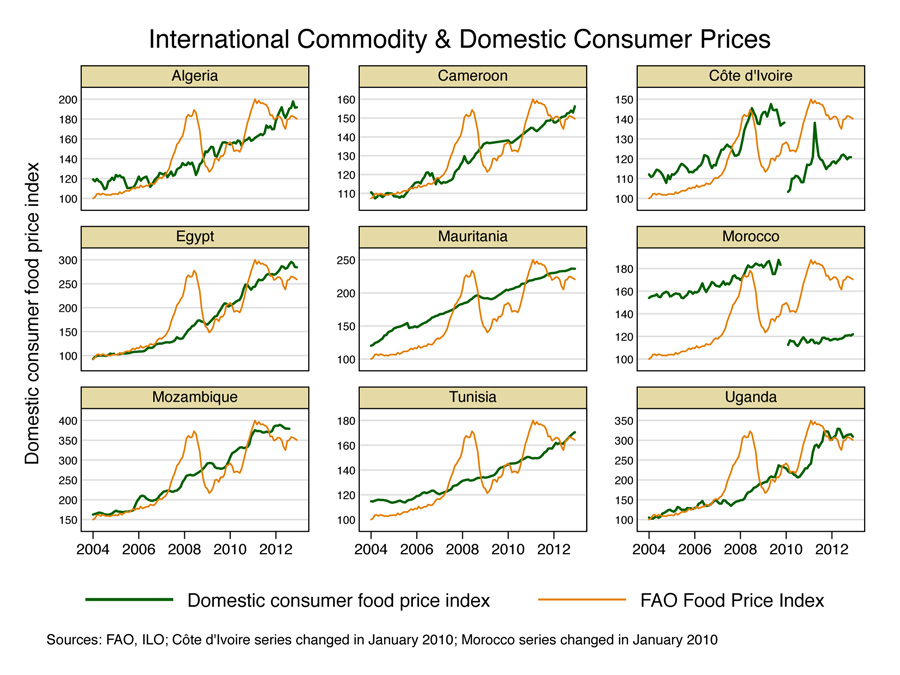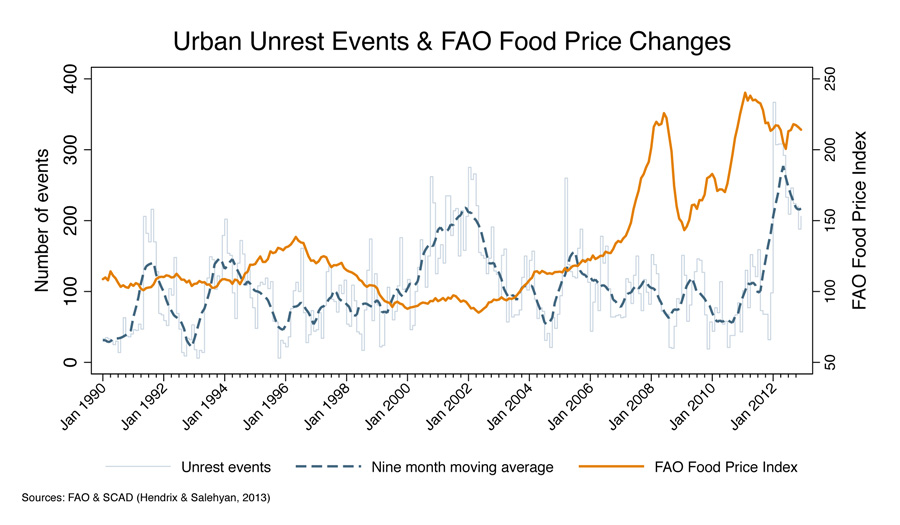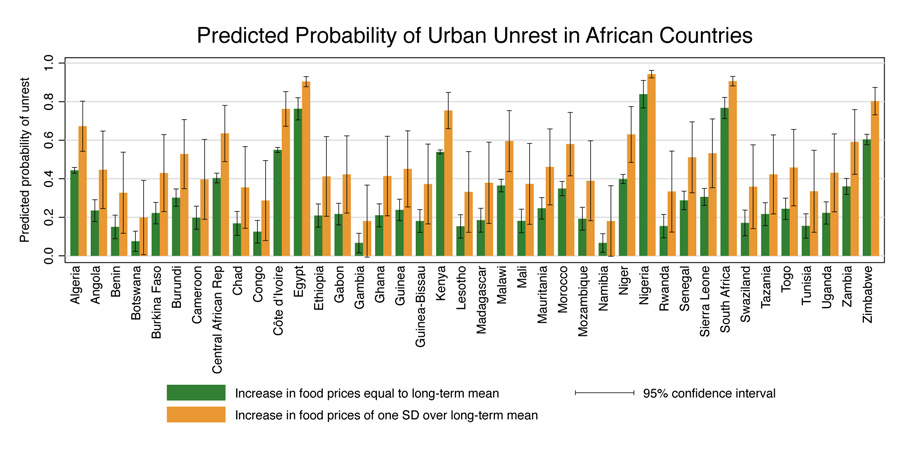-
Feeding Unrest: A Closer Look at the Relationship Between Food Prices and Sociopolitical Conflict
December 8, 2014 By Todd G. Smith
From the Roman poet Juvenal’s observations about bread and circuses to Marie Antoinette’s proclamation, “let them eat cake!” the link between food and political stability is well established in pop culture. In academic and policy circles, however, it’s a source of considerable debate.
Local food prices do not necessarily respond immediately to changes in commodity pricesSince 2008, when the FAO Food Price Index spiked to previously unseen levels, reports of so-called “food riots” have become common. In 2011, researchers at the New England Complex Systems Institute (NECSI) released a short paper presenting a compelling correlation between spikes in the FAO Food Price Index in 2008 (and again in 2011) and media reports of food riots across the Middle East and North Africa. The authors claimed that when political systems fail to provide accessible food, populations have “nothing to lose” and “any incident then triggers death-defying protests and other actions that disrupt the existing order.”
Based on this correlation, NECSI made some rather deterministic predictions about widespread unrest that have been repeated in media outlets since to explain various conflicts around the globe, including the Arab Spring. Prognostications like these are dangerous because they are overly simplistic and reductionist, potentially leading to policy that doesn’t address the actual problem and can even make things worse.
The correlation between FAO Food Price Index levels and conflict does not hold up under close scrutiny – local prices do not necessarily respond immediately to changes in the Index, and it’s hard to determine what constitutes a food riot or if other factors besides food prices are having a larger impact in a restive society.
That doesn’t mean there isn’t a relationship between food prices and conflict; it means there’s still a lot more work to be done to understand it.
In a new article published in the Journal of Peace Research, I explored if and how rising food prices over the past two decades caused socio-political unrest in urban Africa, regardless of the cited grievance (food prices or something else?) or method of protest (“food riot,” demonstration march, labor strike, etc.) and found results that call for some changes to popular thinking.
Correlation ≠ Causation
The simple method of comparing FAO Food Price Index levels with observed “food riots” has several problems.
First, the observed correlation may be the result of a reporting bias that attributes riots to the most easily identifiable cause, in this case, spikes in the FAO Food Price Index. In other words, the media sees unrest, sees the Food Price Index is high (as it has been for the last decade), and assumes they are seeing food-related unrest. This also helps reporters connect local events to an international audience.
Rising food prices are generally accompanied, or in fact caused, by other phenomenaSecond, the FAO Food Price Index measures a basket of prices paid for internationally traded food commodities and does not directly reflect the prices that consumers actually pay. In the “hungry people are angry people” line of thinking, the link between increases in international commodity prices and related events must necessarily be through consumer prices, and while it is true that increases in commodity prices pass through to consumer prices, this pass-through is rarely, if ever, one-to-one or immediate and varies enormously between countries depending on national policies that can insulate economies from the vagaries of international commodity markets. As a result, spikes in the Index are often not felt locally for some time afterward (see Figure 1).
Third, drawing conclusions about causation based on this correlation ignores the complicated and often circular relationship between food prices and unrest. Political and social instability is detrimental to the functioning of all markets, which can drive up the price of everything, including food, creating what is referred to using the rather oxymoronic term “reverse causality.”
Furthermore, rising food prices are generally accompanied, or in fact caused, by other phenomena, economic or otherwise, which can also lead to unrest. Such was the case in Nigeria in January 2012 when the removal of fuel subsidies led to steep increases in fuel costs, which in turn led to increases in food prices and tens of thousands of protesters taking to the streets.
Moving Beyond “Food Riots”
Historically, unrest around food has taken many different forms and been intermingled with many other grievances, especially the availability of employment. There is no reason to suspect this is not true today.
SCAD includes data on over 10,000 occurrences of demonstrations, protests, strikes, riots, coups, and communal conflictsAn article published last year in Food Security found distinct differences in the way the causes of “food riots” in 14 African countries in 2007/08 and 2010/11 were portrayed in the international media versus the local media, suggesting a certain media bias even when focused exclusively on seemingly food-related events. The authors identified four different causal narratives for the unrest, which are similar to the narratives behind many of the different types of bread riots in 18th and 19th century England and France identified by authors such as George Rudé, Charles Tilly, Louise Tilly, John Stevenson, and E.P. Thompson.
To avoid ambiguity around what might constitute a “food riot,” I used an all-inclusive dependent variable in my work, drawn from the University of Texas’ Social Conflict in Africa Database (SCAD), which includes data on over 10,000 occurrences of demonstrations, protests, strikes, riots, coups, and communal conflicts in 48 African countries between 1990 and 2012. I transformed this data into a yes/no variable for the occurrence of unrest of any sort in the urban areas of a given country in a given month.
A simple comparison of counts of unrest events appearing in SCAD and the FAO Index does not suggest a relationship (see Figure 2). But for the reasons already discussed, the Index is not an appropriate independent variable.
Instead, I replaced the Index with monthly changes in the domestic consumer food price indices of 47 African countries from the International Labor Organization. These data are reported by each country for a basket of foodstuffs deemed most relevant in the capital city and other urban centers. As such they are directly reflective of the prices that people actually pay to feed their families. Because food prices, like all prices, are subject to inflation and different countries have experienced different volatility in food prices, I standardized this variable to reflect changes from long-term means.
Sharp monthly increases in consumer food prices lead to significantly higher likelihood of sociopolitical unrestLike Marc Bellemare in his work, I used an instrumental variable approach, a statistical technique that uses a third variable, an instrument, to model changes in the causal variable. This instrument must affect the outcome through, and only through, the causal variable and be unaffected by either the outcome or the causal variable. Assuming these conditions are met, this theoretically eliminates any bias from the circular or coincidental relationship between the outcome and the causal variables.
I used two instruments, separately and jointly. The first is international commodity prices of rice, corn, and wheat, as reported by the International Monetary Fund. Because different countries import, and in some cases export, different amounts of grain, consumer prices vary in their susceptibility to changes in international prices. I therefore generated a single value adjusted for the country-specific trade balance. The second is deviations from expected normal rainfall accumulations in the given country over the previous nine months. Both of these instruments satisfy the necessary criteria and performed well under all available statistical tests.
Local Price Spikes Increase Likelihood of Unrest
In the end, I found that sharp monthly increases in consumer food prices in a particular country lead to significantly higher likelihood of sociopolitical unrest in that country.
All else being equal, the effect of a one standard deviation increase in domestic food prices over the long-term mean increased the odds of unrest by 75 percent. (By comparison, the occurrence of national elections increased the odds of unrest by 64 percent, and the occurrence of unrest in the previous month led to a nearly identical increase in the odds as an increase in food prices.)
Odds are technically different than probability, and the change in the probability of unrest is dependent on the baseline probability of unrest, which varies by country. Figure 3 illustrates the probability of unrest in each country in the analysis, assuming a monthly increase in food prices equal to the long-term mean increase and the probability of unrest given a one standard deviation increase over the long-term mean.
Disaggregating the data by types of events, I find that the effect is strongest when the analysis is limited to spontaneous violent riots and smallest for organized events and almost non-existent for strikes. This is suggestive of the types of events that are driven by rising food prices.
The Lesson? Bolster Local Markets
These findings have important policy implications. Based on the specious correlation between commodity prices and food riots, prominent policy tastemakers, such as economist Jeffrey Sachs and former World Bank President Robert Zoellick, have suggested the appropriate response is to focus on increasing global production, regulating speculation on food crops, and reducing biofuel production.
The world produces enough food to feed all its inhabitants, the failure is in getting it on people’s platesWhile these may be laudable goals (although the last is debatable), they divert attention away from the real problem. The world produces enough food to feed all its inhabitants, the failure is in getting it on people’s plates. This is often a result of failed local markets. Controlling price fluctuations in international markets is important on a macro level but will have little benefit if local markets are still vulnerable to local conditions.
This research shows that price spikes have destabilizing effects regardless of the source (e.g., a local drought or global speculation), and maintaining consistently low prices is less important than preventing sudden price shocks. These principles should guide efforts to prevent food-related instability (though it does not mean countries should institute or maintain price control and subsidy regimes; such policies may control prices but also have other adverse effects that can contribute to political instability).
Priority should be given to improving irrigation infrastructure to increase local production and buffer against changing rainfall patterns; expanding transportation networks to deliver food regionally; increasing local storage capacity to allow for warehousing; and bolstering local and regional commodity exchanges to reduce reliance on international markets, as Ethiopia has done.
These efforts would help stabilize food prices in vulnerable countries in more productive ways than the existing paradigm, and help us understand when instability really is related to food.
Todd G. Smith is a PhD candidate at the Lyndon B. Johnson School of Public Affairs at The University of Texas at Austin and a visiting research scholar at the Center for Social Science Research, University of Cape Town.
Sources: The Economist, Food Security, Foreign Affairs, Foreign Policy, The Guardian, International Labor Organization, International Monetary Fund, Journal of Peace Research, MIT Technology Review, NPR, New England Complex Systems Institute, New York Daily News, The New York Times, PBS, UN Food and Agriculture Organization, University of Texas, Austin, Vice, Wired.
Photo Credit: Streets of Kidal, Mali, November 2014, courtesy of Marco Dormino/UN Photo. Charts: Used with permission courtesy of Todd G. Smith.
 A Publication of the Stimson Center.
A Publication of the Stimson Center.






